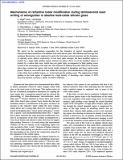Por favor, use este identificador para citar o enlazar a este item:
http://hdl.handle.net/10261/21099COMPARTIR / EXPORTAR:
 SHARE SHARE
 CORE
BASE CORE
BASE
|
|
| Visualizar otros formatos: MARC | Dublin Core | RDF | ORE | MODS | METS | DIDL | DATACITE | |

| Campo DC | Valor | Lengua/Idioma |
|---|---|---|
| dc.contributor.author | Vega, Fidel | - |
| dc.contributor.author | Armengol, Josep | - |
| dc.contributor.author | Diez-Blanco, V. | - |
| dc.contributor.author | Siegel, Jan | - |
| dc.contributor.author | Solís Céspedes, Javier | - |
| dc.contributor.author | Barcones, B. | - |
| dc.contributor.author | Pérez Rodríguez, A. | - |
| dc.contributor.author | Loza Álvarez, P. | - |
| dc.date.accessioned | 2010-02-15T13:42:03Z | - |
| dc.date.available | 2010-02-15T13:42:03Z | - |
| dc.date.issued | 2005-07-08 | - |
| dc.identifier.citation | Applied Physics Letters 87(2): 021109 (2005) | en_US |
| dc.identifier.issn | 0003-6951 | - |
| dc.identifier.uri | http://hdl.handle.net/10261/21099 | - |
| dc.description | 3 pages, 3 figures. | en_US |
| dc.description.abstract | We report on the mechanisms responsible for the formation of optical waveguides upon femtosecond laser irradiation of an alkaline lead-oxide silicate glass. MicroRaman spectroscopy and nonlinear fluorescence were employed to probe the local glass network structure and the formation of optically active defects respectively. At low laser pulse energies, the laser modified region is formed by a single light guiding region, whereas for pulses above 14 µJ the modified region is formed by a central dark zone, which does not guide light, accompanied by light guiding zones located in the surrounding of the dark one. This behavior is different from that observed in common silica glass systems but agrees with recent results obtained in phosphate and heavy metal oxide glasses. However, our results show that, unlike the latter glass, local densification of the glass occurs in the whole laser modified region, i.e., in the dark and the guiding zones. The suppression of light guiding in the dark region is explained by a high density of absorbing color centers. | en_US |
| dc.description.sponsorship | This work was partially supported by CICYT (Spain) under Project No. DPI2002-00151. One of the authors (V.D.B.) acknowledges the financial support of the CSIC and the European Social Fund through an I3P Ph.D. fellowship. Another author (P.L.-A. acknowledges funding from the Spanish Government ( the Ramón y Cajal program and Grant No. TIC2003-07485). | en_US |
| dc.format.extent | 129328 bytes | - |
| dc.format.mimetype | application/pdf | - |
| dc.language.iso | eng | en_US |
| dc.publisher | American Institute of Physics | en_US |
| dc.rights | openAccess | en_US |
| dc.title | Mechanisms of refractive index modification during femtosecond laser writing of waveguides in alkaline lead-oxide silicate glass | en_US |
| dc.type | artículo | en_US |
| dc.identifier.doi | 10.1063/1.1994927 | - |
| dc.description.peerreviewed | Peer reviewed | en_US |
| dc.relation.publisherversion | http://dx.doi.org/10.1063/1.1994927 | en_US |
| dc.type.coar | http://purl.org/coar/resource_type/c_6501 | es_ES |
| item.openairecristype | http://purl.org/coar/resource_type/c_18cf | - |
| item.fulltext | With Fulltext | - |
| item.cerifentitytype | Publications | - |
| item.openairetype | artículo | - |
| item.languageiso639-1 | en | - |
| item.grantfulltext | open | - |
| Aparece en las colecciones: | (CFMAC-IO) Artículos | |
Ficheros en este ítem:
| Fichero | Descripción | Tamaño | Formato | |
|---|---|---|---|---|
| GetPDFServlet.pdf | 126,3 kB | Adobe PDF |  Visualizar/Abrir |
CORE Recommender
SCOPUSTM
Citations
26
checked on 04-abr-2024
WEB OF SCIENCETM
Citations
25
checked on 25-feb-2024
Page view(s)
399
checked on 18-abr-2024
Download(s)
287
checked on 18-abr-2024
Google ScholarTM
Check
Altmetric
Altmetric
NOTA: Los ítems de Digital.CSIC están protegidos por copyright, con todos los derechos reservados, a menos que se indique lo contrario.
